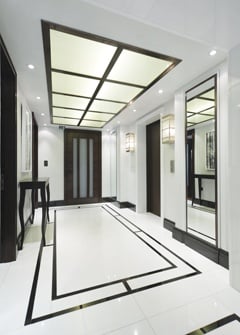Readers Projects : The Connaught Hotel
The refurbishment of one of London’s most prestigious hotels, the Connaught in Mayfair, has seen Blair Associates Architecture open up the front with a Portland limestone winter garden terrace. A new west wing has been built to bridge the gap between the hotel and the mews houses behind it and the interiors have been adorned with a spectacular array of stones from the collection of Italians Antolini Luigi. The stone was worked and fixed by S McConnell & Sons in Northern Ireland for main contractors Chorus on the interiors and Ellmer Construction on the exterior.
Is that…? Yes it is. And that…? Absolutely. If you could see the register of the Connaught Hotel in London, which discretion forbids, it would read like an international who’s who, as it has since the Connaught was built in the 1890s. And the famous faces appear against a backdrop of the no less impressive top echelon of contemporary art.
But it is not the celebrities and the art that NSS are checking as we enjoy a tour of the newly extended and refurbished five-star hotel in the centre of Mayfair between Mount Street and Carlos Place.
Our questions relate to the plethora of marbles and limestones used in the new west wing and the refurbishment of the existing Grade II listed building. “Is that Giallo Siena?” Yes it is. “Is that Flura de Peisa?” Absolutely.
The stones chosen vary from the calm but authoritative background of Portuguese Crème Cascais in the corridors that tie the new west wing visually back to the original building to the splash of colour of exotic onyx and marbles that make statements in both public areas and individual rooms.
The architects made their selection from the extensive catalogue of Italian suppliers Antolini Luigi and the stone was worked in Northern Ireland at the workshops of
S McConnell & Sons in Kilkeel, Co Down, whose masons also fixed the stone at the hotel.
There is a lot of it: 4,000m2 of Thassos Marble, 2,600m2 of Mystery White, 2,000m2 of Crème Cascais, 650m2 of Anthracite, 400m2 of Grigio Carnico, 250m2 of Grigo Armania, 100m2 of Cremo Tirreno, 100m2 of Irish Connemara marble, 20m2 of Imperial White, 100m2 of York sandstone paving and 40m3 of Portland stone.
There was a lot of other stone used in the Connaught project in smaller quantities – Travertine, Kilkenny limestone, Absolute Black, Carrara marble, Bardiglio Nuvolato and Nero Marquina, as well as onyx, Giallo Siena and Flura de Peisa.
Portland Basebed limestone from Albion Stone was used for the new winter garden added to the front of the building. It is there in contradiction of conventional wisdom that says you can’t get planning permission to build at the front of a listed building.
Michael Blair, the architect from Blair Associates Architecture Ltd, ignored that conventional wisdom and applied for planning permission for the winter garden anyway – and got it, although he had to spend some time explaining the proposal to the Victorian Society, the Westminster planning authority and English Heritage. In the end they all welcomed the change.
He says the architecture of the Connaught is less impressive than the hotel’s guest list. It was an introverted design that he wanted to open up by adding the winter garden terrace with its large areas of glazing.
It is a testament to the sympathy of the design to the existing building that many who see it – even those who knew the building before – think it has always been there.
The exterior Portland stonework was also produced and fixed by stone specialists S McConnell & Sons.
Blair Associates Architecture have also created a new west wing to replace the unsympathetic work that was added after World War Two, possibly to repair bomb damage.
The task was to create a bridge between the Connaught and neighbouring brick mews houses. This has been achieved by using both brick and Portland limestone in the development, while avoiding pastiche and making it a clearly modern intervention through the use of steel and glass. The result is exceptionally good contextual urban design.
There are a lot of fascinating elements to the work that has been carried out at the Connaught, some of them pictured here. It even saw the first new ballroom built in London for 150 years.

